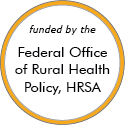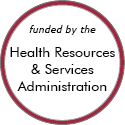Rural Project Examples: Health conditions
Other Project Examples
Win With Wellness

Updated/reviewed October 2025
- Need: To reduce risk of obesity and chronic disease in rural northwest Illinois.
- Intervention: Win With Wellness (WWW) collaborated with community organizations and worksites to improve physical activity and eating behaviors and reduce weight among adults using a multi-component approach.
- Results: From 2015 to 2018, the two participating counties initiated 28 Take Off Pounds Sensibly (TOPS) groups with 367 participants. In the second round of funding, WWW recruited 183 participants for 9 TOPS groups and 8 community Heart-to-Heart sites.
HopeWest
Updated/reviewed September 2025
- Need: To provide accessible and affordable services to address the challenges associated with aging, serious illness, and grief across rural western Colorado.
- Intervention: A nonprofit, community-sustained healthcare model was created to provide the Program of All-Inclusive Care for the Elderly (PACE), dementia support, hospice care and palliative care, as well as grief support services for individuals of all ages.
- Results: Since 1993, HopeWest has grown to serve more than 3,000 patients and families annually across five counties in western Colorado.
Age-Friendly and Dementia-Friendly Winnemucca
Updated/reviewed August 2025
- Need: To educate rural community members about Alzheimer's disease and other dementias and to support older adults with dementia and caregivers in need.
- Intervention: A community group formed in Winnemucca, Nevada, to discuss topics like health, housing, social events, community improvement, education, and transportation for older adults. The group also provides outreach to older adults, caregiver support, and a variety of educational activities and events.
- Results: The group's efforts have led to many changes for community welfare and safety as well as opportunities for education and activities.
COPD Readmission Prevention Program
Updated/reviewed August 2025
- Need: Organized focus on COPD patients' medical needs to decrease hospital readmissions in a rural Ohio healthcare system.
- Intervention: Creation of an integrated system model with nurse navigators central to evidence-based chronic disease care management approaches to COPD care.
- Results: Since its creation in 2014, the model continues to mature its comprehensive approach to provide optimized acute and chronic care for the area's COPD patients.
It's a Girl Thing: Making Proud Choices
Updated/reviewed June 2025
- Need: Teen pregnancy, sexually transmitted diseases, and mental health challenges in adolescent girls were concerns for members of Union Parish, Louisiana.
- Intervention: Union General Hospital, a Critical Access Hospital, created the program It's a Girl Thing: Making Proud Choices to teach prevention, self-confidence, personal responsibility, and mental well-being to teen girls.
- Results: Teen pregnancy rates in Union Parish have dropped by more than 40% since the start of the program, significantly exceeding the program's initial goal of 5%. Graduation rates have also increased. The addition of Together We Can Be Bully Free as an integral part of It's a Girl Thing has further expanded mental health support for participants.
Positively Living & Choice Health Network
Updated/reviewed May 2025
- Need: To provide affirming, destigmatized healthcare and support to thousands of Tennesseans living with HIV/AIDS, mental illness, substance use disorder, and homelessness – and prevention services for individuals at risk of contracting HIV.
- Intervention: Positively Living & Choice Health Network provides services including a medical clinic, pharmacy, therapy, case management, client services like housing aid and transportation, HIV prevention, and a harm reduction program.
- Results: The program currently serves 5,000 individuals and families through its offices in Knoxville, Chattanooga, Memphis, and Cookeville and its mobile medical unit for rural communities in Cocke and Claiborne counties.
Queen Anne's County Mobile Integrated Community Health (MICH) Program
Updated/reviewed May 2025
- Need: To connect patients to resources in order to reduce use of emergency services, emergency department visits, and hospital readmissions.
- Intervention: Patients receive support (by in-person visit, phone call, or telehealth visit) from a paramedic, community health nurse, peer recovery specialist, and pharmacist.
- Results: Between July 2016 and March 2024, the program made 1,098 patient contacts and continued to see a reduction in emergency department and inpatient visits and costs.
Pacific AIDS Education and Training Center-Nevada

Updated/reviewed April 2025
- Need: To improve and increase prevention and care services for HIV, STDs, hepatitis C, and other infectious diseases.
- Intervention: PAETC-NV provides clinical and didactic trainings, conferences, technical assistance, capacity building, webinars, and other services to providers and healthcare organizations statewide.
- Results: In 2024, PAETC-NV trained more than 1,800 healthcare providers across Nevada to increase clinical capacity in the care, screening, and prevention of HIV, other sexually transmitted diseases, and hepatitis C.
The Possibility Shop
Updated/reviewed March 2025
- Need: To connect people in need in Allegany County, Maryland, to health and human services and to items like hygiene products, food, and clothing.
- Intervention: The Possibility Shop partners with health organizations, insurance navigators, food banks, and other agencies.
- Results: In 2024, 15,246 service encounters occurred and 940 intakes to services were performed.
University of Virginia Diabetes Tele-Education Program

Updated/reviewed March 2025
- Need: To educate people in rural Virginia who either have diabetes or are considered at high risk for developing it.
- Intervention: Teleconferencing technology is used to offer diabetes education programs to people with diabetes or those at high risk for developing it. Health professionals are also indirectly trained in diabetes care and management.
- Results: Participants reported better prevention practices and/or self-management of diabetes after being thoroughly educated about this condition.
For examples from other sources, see:
